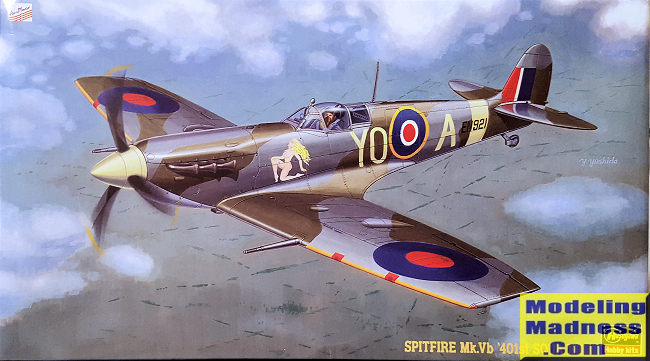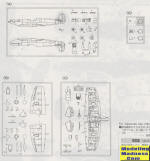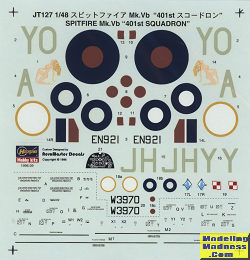
Hasegawa 1/48 Spitfire Vb '401 Squadron'
| KIT #: | 09187 (Jt 127) |
| PRICE: | 2200 yen when new |
| DECALS: | Two options |
| REVIEWER: | Scott Van Aken |
| NOTES: | 1996 release. Aeromaster decals. |

| HISTORY |
The Vb became the main production version of the Mark Vs. Along with the new Merlin 45 series the B wing was fitted as standard. As production progressed changes were incorporated, some of which became standard on all later Spitfires. Production started with several Mk Ibs which were converted to Mk Vbs by Supermarine. Starting in early 1941 the round section exhaust stacks were changed to a fishtail type, marginally increasing exhaust thrust. Some late production Vbs and Vcs were fitted with six shorter exhaust stacks per side, similar to those of Spitfire IXs and Seafire IIIs; this was originally stipulated as applying specifically to Vb(trop)s. After some initial problems with the original Mk I size oil coolers, a bigger oil cooler was fitted under the port wing; this could be recognised by a deeper housing with a circular entry. From mid-1941 alloy covered ailerons became a universal fitting.
A constant flow of modifications were made as production progressed. A "blown" cockpit hood, manufactured by Malcolm, was introduced in an effort to further increase the pilot's head-room and visibility. Many mid to late production Vbs – and all Vcs – used the modified, improved windscreen assembly with the integral bullet resistant centre panel and flat side screens introduced with the Mk III. Because the rear frame of this windscreen was taller than that of the earlier model the cockpit hoods were not interchangeable and could be distinguished by the wider rear framing on the hood used with the late-style windscreen.
Different propeller types were fitted, according to where the Spitfire V was built: Supermarine and Westland manufactured Vbs and Vcs used 10 ft 9 in (3.28 m) diameter, 3 bladed de Havilland constant speed units, with narrow metal blades, while Castle Bromwich manufactured Vbs and Vcs were fitted with a wide bladed Rotol constant speed propeller of either 10 ft 9 in (3.28 m) diameter, with metal blades, or (on late production Spitfires) 10 ft 3 in (3.12 m) diameter, with broader, "Jablo" (compressed wood) blades. The Rotol spinners were longer and more pointed than the de Havilland leading to a 3.5 in (8.9 cm) increase in overall length. The Rotol propellers allowed a modest speed increase over 20,000 ft (6,100 m) and an increase in the service ceiling. A large number of Spitfire VBs were fitted with "gun heater intensifier" systems on the exhaust stacks. These piped additional heated air into the gun bays. There was a short tubular intake on the front of the first stack and a narrow pipe led into the engine cowling from the rear exhaust.
The Vb series were the first Spitfires able to carry a range of specially designed slipper-type drop tanks which were fitted underneath the wing centre-section. Small hooks were fitted just forward of the inboard flaps. When the tank was released, these hooks caught the trailing edge of the tank, swinging it clear of the fuselage.
With the advent of the superb Focke-Wulf Fw 190 in August 1941 the Spitfire was for the first time truly outclassed, hastening the development of the "interim" Mk IX. To counter this threat, especially at lower altitudes, the Vb was the first production version of the Spitfire to use clipped wingtips as an option, reducing the wingspan to 32 ft 2 in (9.8 m). The clipped wings increased the roll rate and airspeed at lower altitudes. Several versions of the Merlin 45/50 family were used, including the Merlin 45M which had a smaller "cropped" supercharger impeller and boost increased to +18 lb. This engine produced 1,585 hp (1,182 kW) at 2,750 ft (838 m), increasing the L.F VB's maximum rate of climb to 4,720 ft/min (21.6 m/s) at 2,000 ft (610 m).
The Mk Vb(trop) (or type 352) could be identified by the large Vokes air filter fitted under the nose; the reduced speed of the air to the supercharger had a detrimental effect on the performance of the aircraft, reducing the top speed by 8 mph (13 km/h) and the climb rate by 600 ft/min (3.04 m/s), but the decreased performance was considered acceptable. This variant was also fitted with a larger oil tank and desert survival gear behind the pilot's seat. A new desert camouflage scheme was applied. Many Vb(trop)s were modified by 103 MU (Maintenance Unit-RAF depots in which factory fresh aircraft were brought up to service standards before being delivered to squadrons) at Aboukir, Egypt by replacing the Vokes filter with locally manufactured Aboukir-type filters, which were lighter and more streamlined. Two designs of these filters can be identified in photos; one had a bulky, squared off filter housing while the other was more streamlined. These aircraft were usually fitted with the wide blade Rotol propeller and clipped wings.
| THE KIT |

One needs to open holes in the lower wing piece if one wants to install the bomb and rack. There are inserts for the lower cowling, which is attached after the fuselage halves are assembled and the wing put in place. Note that the wings have the option of either a clipped wing tip or the standard tips.
Landing gear i well done for
the scale and the kit comes with the proper lower wing radiators. Unlike later
Spit kits from others, the large radiator is molded in place with a separate
exhaust door. The smaller oil cooler is a left and right side. There are
alternate prop/spinner combinations. One is a deHavilland prop and the other a
Rotol. Also optional are separate canopies. Note that these lo ok
to be too thick to be able to pose them open. The exhaust stacks are three on
each side and they are separate items.
ok
to be too thick to be able to pose them open. The exhaust stacks are three on
each side and they are separate items.
The kit provides the basic instructions for the Mk.Vb with an addendum sheet for the two markings options. Unfortunately, you are not told which prop or which canopy to use with the two aircraft, though you might be able to glean some info from the base instruction's painting guide. One is the box art plane from 401 Squadron in mid 1943. The other is with 317 Squadron. This has an unusually small fuselage roundel. The decals are by Aeromaster so will prove to be thin. A full stencil suite is also provided.
| CONCLUSIONS |
Apparently, the Hasegawa Spitfires are a scale 4" too short (that's 1/12 of an inch on the model). I've built these kits and really don't see that much of an issue in that regard. However, there are fan-boys to which that makes the kit unbuildable. Fine. The kit is not fiddly, builds into a nice representation of the aircraft and looks good on the shelf. They can also be found at a resonable price second hand, if so inclined.
| REFERENCES |
July 2022
Copyright ModelingMadness.com. All rights reserved. No reproduction in part or in whole without express permission from the editor.
If you would like your product reviewed fairly and fairly quickly, please contact the editor or see other details in the Note to Contributors.